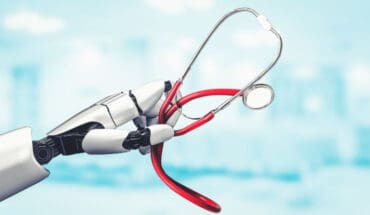In medical emergencies, people living in remote and rural areas can be disadvantaged, having to travel many miles to a hospital in order to receive a diagnosis. The University of Aberdeen, NHS Highland and the Scottish Ambulance Service are testing new technology which enables paramedics to send high-quality video and ultrasound images ahead of a patient’s arrival at hospital. This allows hospital-based specialists to provide expert advice to paramedics during long journeys, and will potentially improve outcomes for patients.
The ‘SatCare’ trial, which aims to involve 1000 patients a year, is part-funded by the European Space Agency and uses state-of-the-art scanning and communications technology to transmit high-bandwidth images to the emergency department of Raigmore Hospital in Inverness. The trial is investigating whether transmission of video and ultrasound will lead to better treatment in the ambulance and more streamlined care on arrival at the hospital (such as immediate transfer to an operating theatre).
The trial is investigating whether transmission of video and ultrasound will lead to better treatment in the ambulance and more streamlined care on arrival at the hospital (such as immediate transfer to an operating theatre).
Working with experts from the global broadband services and technology company, ViaSat, experts have installed point-of-care ultrasound and satellite communication systems in five ambulances in the Scottish Highlands. The technology has already been tested successfully on healthy volunteers, and this is the first time it will be used in emergency situations. The trial is focusing on several potentially life-threatening conditions: major trauma, chest pain, shortness of breath, abdominal pain and circulatory shock, all of which could benefit from more accurate early diagnosis.
Dr Leila Eadie, Research Fellow at the University of Aberdeen’s Centre for Rural Health, explains: “We are taking diagnostic tools used in the emergency department into rural ambulances, making them available at the site of an emergency. Previous studies have shown the biggest barrier to practical use of pre-hospital ultrasound is interpretation of the scans: images can be acquired with basic training and SatCare will facilitate expert assessment of images in the field. We want to maximise the benefits of having ultrasound available without requiring paramedics to undertake extensive sonography training.”
Five ambulance stations around the Scottish Highlands are taking part, with paramedics trained to rapidly perform appropriate scans. Scans take less than five minutes to record and they are then transmitted with a video summary of the patient’s condition via satellite to the emergency consultants, who assess the patient’s needs and give advice and feedback to the paramedic. The consultant also has the added benefit of knowing what to expect when the patient arrives and can mobilise any resources or specialist teams required.
Dr Luke Regan, Emergency Consultant at Raigmore Hospital, said: “Point of care ultrasound, telemedicine and remote decision support have all offered potential over the years to improve care for our patients, but have often failed to secure the kinds of rigorous and substantial research platforms that allow firm conclusions to be made about efficacy. This trial aims for the numbers, methodological rigour and rural patient base that all offer a real prospect of informing the debate on these interventions positively for years to come.
“A European Space Agency geared towards satellite technologies that have real benefit to people on the ground and a Scottish Ambulance Service prepared to engage with prehospital research at scale, along with university, health board and industry partners has been the key to the project’s progress thus far.”
Professor Philip Wilson, Director of the Centre for Rural Health said: “This trial is a landmark in rural emergency care research. It will establish the best way to use very sophisticated technology to support paramedics in caring for sick patients on the long journey to hospital and to alert A&E staff to what kind of treatments may be needed when the patient arrives. This research will tell us how effective and, equally important, how cost-effective this technology can be.”
Dr Jim Ward, Medical Director of the Scottish Ambulance Service said: “The Scottish Ambulance Service is committed to testing and applying the innovative use of technology to improve outcomes for patients. We are delighted to participate in this research project, which may ultimately lead to changes and improvements in how we practice across Scotland.”
Marc Agnew, vice president, ViaSat Europe, said: “The innovative satellite broadband communication solutions we have created for the SatCare trial will allow transmission of high-bandwidth video summaries and ultrasound scans in areas of the Highlands where mobile phones and traditional emergency services communications encounter problems. The equipment is simple to use, easy to install and most importantly can potentially bring considerable benefits to both paramedics and patients in emergency situations.”
- 1 ¼ Million new mums miss out on free access to NHS dentistry - 23rd April 2024
- Breakthrough in child chronic respiratory diseases - 11th April 2024
- Protein could help detect delayed concussion recovery - 11th April 2024







Thanks for sharing great post. Medical emergencies are an unfortunate event when they occur. Many of the rural area people are suffering through the health crisis due to scarcity of doctors, hospital and not getting proper medical treatments. To protect such poor people, one can take small measures by supporting the humanitarian mission, view more information here http://www.mission-humanitaire-afrique.org about the mission and contribute and support to the poor people.
Telemedicine is a game-changer for medical emergencies in rural areas. By leveraging technology, it ensures prompt access to healthcare expertise, regardless of location. This revolutionary approach has the potential to save lives and bridge the gap in rural healthcare. Kudos to telemedicine for transforming the way we deliver critical care!